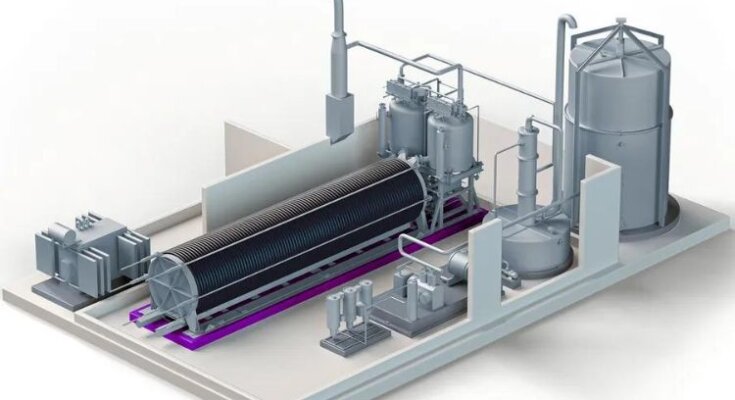As the world increasingly shifts towards sustainable energy solutions, the role of electrolysers has become paramount in the hydrogen production landscape. The global electrolyser market size reached a value of about USD 461.85 million in 2023. The market is further estimated to grow at a compound annual growth rate (CAGR) of 27.30% during the forecast period of 2024-2032, aiming to reach a value of around USD 4,054.68 million by 2032. This significant growth highlights the critical importance of electrolysers in the transition to cleaner energy sources, reducing carbon footprints, and enhancing energy security.
Table of Contents
Market Overview
Electrolysers are devices that facilitate the process of electrolysis, where water is split into hydrogen and oxygen using electricity. This technology is vital for producing green hydrogen, which is seen as a key element in decarbonizing various sectors, including transportation, industry, and power generation. As countries worldwide commit to net-zero emissions targets, the demand for efficient hydrogen production technologies is on the rise, positioning the electrolyser market as a focal point in the renewable energy sector.
Market Segmentation
Understanding the different segments within the electrolyser market is crucial for grasping its growth potential.
By Product
- Alkaline Electrolyser Alkaline electrolysers, one of the most established technologies, use a liquid alkaline solution as an electrolyte. They are known for their robustness and relatively low production costs. Currently, they hold a significant share of the market and are expected to continue growing due to their reliability and scalability.
- Solid Oxide Electrolyser Solid oxide electrolysers (SOEs) operate at high temperatures and have the potential for high efficiency. Although they are still in the developmental stage compared to alkaline models, advancements in materials and technology could lead to wider adoption in the coming years.
- PEM Electrolyser Proton Exchange Membrane (PEM) electrolysers are gaining traction due to their ability to operate at variable loads and their quick response times, making them ideal for integration with renewable energy sources. The market for PEM electrolysers is expected to expand significantly as the push for flexible and responsive energy systems grows.
By Capacity
The electrolyser market can also be segmented by capacity:
- Less than 500 kW Smaller electrolysers are often used in pilot projects and niche applications. Their market is driven by the increasing interest in decentralized hydrogen production.
- 500 kW – 2 MW This range represents a significant portion of the market, catering to commercial and industrial applications. The growing demand for hydrogen in transportation and energy generation is boosting this segment.
- Above 2 MW Large-scale electrolysers are essential for hydrogen production at an industrial scale. As major projects develop, this segment is poised for considerable growth, driven by investments in hydrogen infrastructure.
By Application
The applications of electrolysers are diverse and growing:
- Transportation Hydrogen fuel cell vehicles are a promising avenue for the use of electrolysers, enabling a shift away from fossil fuels in the transport sector.
- Power Generation Electrolysers can help balance renewable energy supply and demand, providing a means to store excess energy in the form of hydrogen, which can later be converted back to electricity.
- Industry Feedstock Hydrogen is a crucial feedstock in various industrial processes, including refining and ammonia production. The demand from these sectors is a significant driver for the electrolyser market.
- Industry Energy Electrolysers can improve energy efficiency within industries, contributing to the overall sustainability efforts.
- Others Emerging applications, such as hydrogen-based heating systems, are also entering the market, indicating further potential for growth.
Regional Analysis
The electrolyser market is witnessing varied growth dynamics across different regions:
North America
The North American market is characterized by a robust investment landscape and supportive government policies aimed at promoting hydrogen as a clean energy solution. Companies in this region are actively engaged in research and development to enhance electrolyser technology.
Europe
Europe is at the forefront of the hydrogen economy, with ambitious policies and funding initiatives supporting the electrolyser market. The European Union’s Green Deal and various national strategies aim to boost hydrogen production significantly.
Asia-Pacific
The Asia-Pacific region, particularly countries like Japan, South Korea, and China, is rapidly embracing hydrogen technologies. The demand for hydrogen in energy transition and industrial applications is driving market growth in this region.
Rest of the World
Emerging markets in Africa and Latin America are beginning to explore hydrogen production as part of their energy transition strategies, presenting new opportunities for electrolyser manufacturers.
Competitive Landscape
The competitive landscape of the electrolyser market is becoming increasingly dynamic. Key players are investing in innovation, partnerships, and technological advancements to strengthen their market positions. Major companies are focusing on enhancing efficiency, reducing costs, and expanding their production capacities to meet the growing demand.
Trends and Forecast (2024-2032)
Several trends are expected to shape the electrolyser market over the coming years:
- Technological Advancements: Continuous improvements in electrolyser technologies will lead to enhanced efficiency and reduced costs, making hydrogen production more viable.
- Government Support: Increased investment and favorable policies from governments worldwide will further propel market growth.
- Collaboration and Partnerships: Collaborations between industries, research institutions, and governments will foster innovation and accelerate the development of hydrogen projects.
The market is projected to grow significantly, with an emphasis on both technological advancements and the establishment of a comprehensive hydrogen infrastructure.
Challenges and Opportunities
Despite the optimistic outlook, the electrolyser market faces several challenges, including high initial costs and the need for significant investments in infrastructure. However, these challenges also present opportunities for innovation and growth. As technologies mature and costs decrease, the market is likely to attract more investment and interest.




